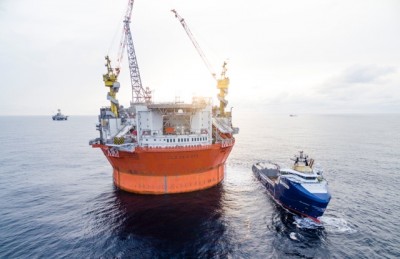Oil prices have fallen recently and so has the value of Norway’s currency, the krone, but that’s not dampening enthusiasm for those who still view the oil industry as extremely important. Local officials along the coast of Northern Norway, meanwhile, are cheering the country’s new oil exploration bonanza in the Barents Sea.

The government’s decision this week to open up a record number of potential new oil fields in the Arctic has been blasted by the fishing industry but embraced by officials in areas that stand to benefit as bases for oil activity. “I think this is an important step in the right direction,” Runar Sjåstad, county mayor in Finnmark for the Labour Party, told Norwegian Broadcasting (NRK). “Oil and gas is a part of the future and not just the past up here in the north.”
His party fellow in the North Cape town of Honningsvåg, Mayor Kristina Hansen, was celebrating the decision to develop oil fields in the Barents. Hansen has long been lobbying for Statoil to land its oil and gas from its Johan Castberg project at Kaupang, just outside Honningsvåg, because of the economic development it can bring in addition to the tourism industry.
“I think it’s great to search intensively in the Barents Sea, and show that you have faith that there are resources out there,” Hansen told NRK. She rejected arguments from environmentalists like Frederic Hauge of Bellona, who’s calling for a halt to the massive exploration on as many as 102 blocs of the Norwegian and Barents seas. A major lawsuit that’s due for trial later this year also seeks to halt oil activity in the Arctic because of the threat it poses to the environment.
“It’s extreme to stop this,” Hansen said. “We should explore and see what we find. We shouldn’t produce if it’s not defensible for nature and people, but exploration activity is not indefensible.” She thinks both the exploration activity and, eventually, production can create many opportunities for Finnmark within a sustainable framework.
Sjåstad also calls for “sustainable” oil production if any is found in the 24th licensing round. The oil activity should also take existing industries like fishing into consideration, Sjåstad said, and create employment opportunities and growth in the north.
Oil price down, but demand remains
When oil prices collapsed in 2014, however, and dipped below USD 30 a barrel just over a year ago, the future of expensive and risky Arctic exploration was thrown into question. Barents drilling and production would not be profitable at such a level and prospects improved only after oil prices climbed back up to nearly USD 60 a barrel. They’ve fallen back again, and currently stand at around USD 51 a barrel, weakening the krone yet again as it traded against the US dollar at as much as NOK 8.60 in recent days.
Norwegians seem nonetheless to retain confidence in their economy, with state statistics bureau SSB (Statistics Norway) reporting late last week that most still think their household economy will improve. Interest rates remain low and employers are more optimistic than they’ve been for a long time, NRK reported Tuesday morning. That suggests the job market in Norway will continue to improve.
Officials at state oil company Statoil, which serves as the locomotive for Norway’s oil and offshore industries, are also more optimistic and bullish about prospects. Newspaper Dagens Næringsliv (DN) reported just before the weekend that even though oil prices have fallen more than 10 percent, demand for oil is climbing again.
“We think this will even out,” Arne Sigve Nylund, chief of Statoil’s operations on the Norwegian Continental Shelf, told DN. He stands by Statoil’s predictions that oil prices will rise back up to USD 80 a barrel by 2030. At that level, Arctic projects coming on line can be profitable.
“There’s nothing wrong with demand,” Nylund said. He and his colleagues at Statoil think oil and gas will still provide half of the world’s energy in 2040. They’re not alone, with noted oil consultant Jarand Rystad of Oslo predicting an oil price of USD 93 in 2020.
newsinenglish.no/Nina Berglund

